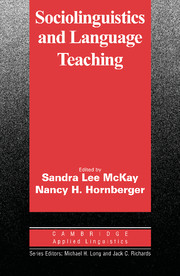14 - Language and education
Published online by Cambridge University Press: 22 July 2009
Summary
The foregoing chapters have made it abundantly clear that language in all its societal, variational, interactional, and cultural diversity both influences and is influenced by education. Education is the site where, on the one hand, broad social and political forces are reflected in the kinds of educational opportunities offered to speakers of different language varieties and, on the other, language use mediates the participation of these speakers in those opportunities and, ultimately, their potential contributions to the larger society.
Consider the following narrative vignettes from my own ethnographic research on language and literacy learning among language minorities in the United States and Peru.
July 13, 1983
Victoria, now age 33, was born and finished primary school in Kinsachata, a rural Quechua-speaking community of highland Puno, Peru. She then roomed alone in Lampa, about 35 to 40 kilometers away, in order to attend the colegio [high school] there, the closest colegio to her home. Although many of her teachers were Quechua-speaking, and may have occasionally used Quechua informally with their students, the medium of instruction for both her primary and secondary education was Spanish.
Upon completing secondary school, she entered and won a competition to go to Spain and receive training at the Escuela Universitaria de Instructoras Rurales [University School for Rural Instructors].
- Type
- Chapter
- Information
- Sociolinguistics and Language Teaching , pp. 449 - 473Publisher: Cambridge University PressPrint publication year: 1995
- 1
- Cited by

